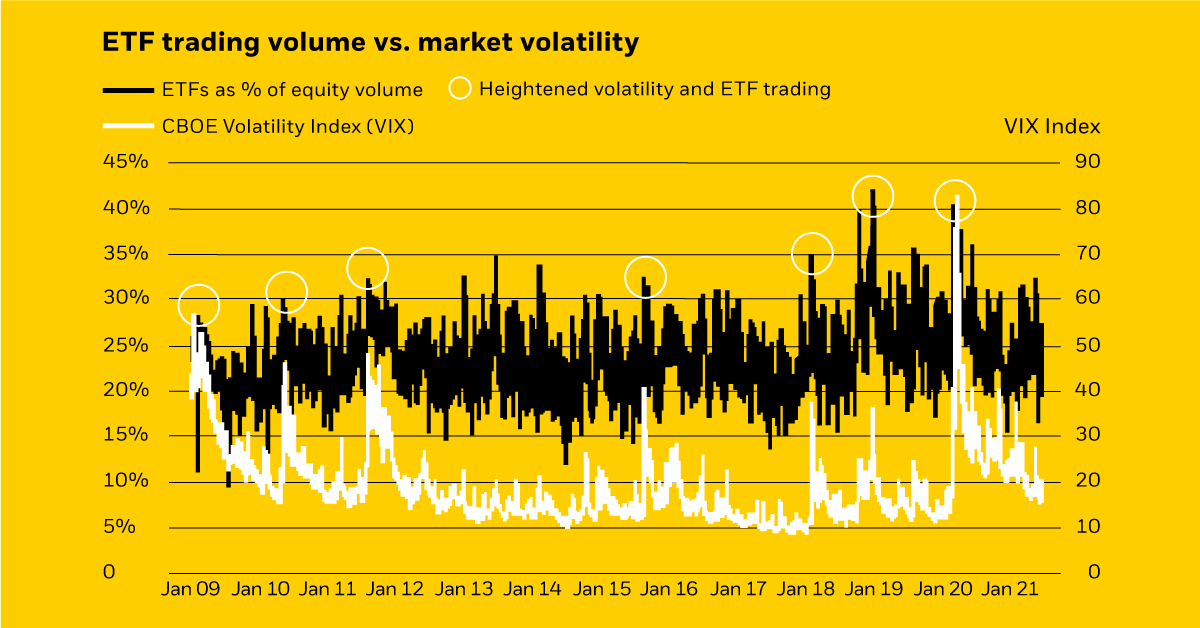Navigating Market Volatility: Why ETFs Are Critical Tools
The following content is sponsored by iShares

Download the ETF Snapshot for free.
Why ETFs Are Critical Tools During Market Volatility
Investors experienced record-breaking volatility in 2020. During COVID-19 market turbulence, the CBOE Volatility index surpassed the previous peak seen in 2008.
In this infographic from iShares, we explore how ETFs rose in popularity during this time—and the characteristics that make them particularly useful during market volatility. It’s the first in a five-part series covering key insights from the ETF Snapshot, a comprehensive report on how institutional investors manage volatility.
The Methodology
To assess how institutional investors navigated this volatility, Institutional Investor published a report in 2021 based on a survey of 766 decision makers. Respondents were from various types of organizations, firm sizes, and regions.
For instance, here is how responses broke down by location:
- 21% Asia Pacific
- 36% North America
- 29% Europe, Middle East and Africa
- 14% Latin America
Here’s what the survey found.
Rebalancing During Market Volatility
In total, 90% of institutional investors said they rebalanced their portfolios between the first and third quarter of 2020. How did they do it?
Among all financial tools, ETFs were the most popular vehicle for rebalancing. For instance, ETFs were used by 70% of investors globally, compared to the 51% who used mutual funds or derivatives.
The popularity of ETFs was evident in market activity. From January to March 2020, ETFs as a proportion of total equity trading volume increased.
| January 2020 | February 2020 | March 2020 | |
|---|---|---|---|
| VIX | 14 | 20 | 58 |
| ETF trading volume | $95B | $136B | $240B |
| ETF as % of equity volume | 26% | 27% | 36% |
Based on an average of daily values. Reflects all listed U.S. ETFs across all asset classes.
This trend is true historically as well, as ETF trading volume has typically spiked during periods of volatility.
Want more institutional insights into ETFs?
Download The ETF Snapshot for free.
The Attributes Driving ETF Usage
Why are ETFs preferred by institutional investors? They offer three key characteristics:
- Liquidity: ETFs make it much simpler to buy and sell large portfolios instantly, instead of trading individual securities.
- Transparency: Among multi-asset managers, transparency of holdings is the top reason for using ETFs. A clear holdings breakdown helps these managers achieve exposures to particular asset classes, sectors, and styles.
- Efficiency: ETFs can be traded quickly. They typically also have lower transaction costs relative to the underlying basket of securities.
Based on these key benefits, ETFs were an invaluable tool during extreme market volatility.
Growing Momentum
ETFs are also poised to help institutional investors navigate the market going forward. Globally, 65% of institutional investors plan to increase their use of ETFs in the future.
In fact, this is already coming to fruition. As of September 2021, the average daily trading volume of ETFs was up more than 5% compared to 2020.
Evidently, ETFs play a critical part in helping institutional investors achieve their goals.
Download the ETF snapshot for free.
-

 Sponsored3 years ago
Sponsored3 years agoMore Than Precious: Silver’s Role in the New Energy Era (Part 3 of 3)
Long known as a precious metal, silver in solar and EV technologies will redefine its role and importance to a greener economy.
-

 Sponsored7 years ago
Sponsored7 years agoThe History and Evolution of the Video Games Market
Everything from Pong to the rise of mobile gaming and AR/VR. Learn about the $100 billion video games market in this giant infographic.
-

 Sponsored8 years ago
Sponsored8 years agoThe Extraordinary Raw Materials in an iPhone 6s
Over 700 million iPhones have now been sold, but the iPhone would not exist if it were not for the raw materials that make the technology...
-

 Sponsored8 years ago
Sponsored8 years agoThe Industrial Internet, and How It’s Revolutionizing Mining
The convergence of the global industrial sector with big data and the internet of things, or the Industrial Internet, will revolutionize how mining works.









